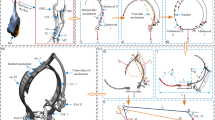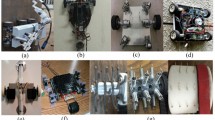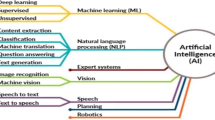Abstract
In research on small mobile robots and biomimetic robots, locomotion ability remains a major issue despite many advances in technology. However, evolution has led to there being many real animals capable of excellent locomotion. This paper presents a “parasitic robot system” whereby locomotion abilities of an animal are applied to a robot task. We chose a turtle as our first host animal and designed a parasitic robot that can perform “operant conditioning”. The parasitic robot, which is attached to the turtle, can induce object-tracking behavior of the turtle toward a Light Emitting Diode (LED) and positively reinforce the behavior through repeated stimulus-response interaction. After training sessions over five weeks, the robot could successfully control the direction of movement of the trained turtles in the waypoint navigation task. This hybrid animal-robot interaction system could provide an alternative solution to some of the limitations of conventional mobile robot systems in various fields, and could also act as a useful interaction system for the behavioral sciences.
Similar content being viewed by others
References
Holzer R, Shimoyama I. Locomotion control of a bio-robotic system via electric stimulation. Proceedings of the IEEE/RSJ International Conference on Intelligent Robots and Systems, 1997, 3, 1514–1519.
Talwar S K, Xu S, Hawley E S, Weiss S A, Moxon K A, Chapin J K. Behavioural neuroscience: Rat navigation guided by remote control. Nature, 2002, 417, 37–38.
Pi X, Li S, Xu L, Liu H, Zhou S, Wei K, Wang Z, Zheng X, Wen Z. A preliminary study of the noninvasive remote control system for rat bio-robot. Journal of Bionic Engineering, 2010, 7, 375–381.
Zhang D, Dong Y, Li M, Wang H. A radio-telemetry system for navigation and recording neuronal activity in free-roaming rats. Journal of Bionic Engineering, 2012, 9, 402–410.
Sun C, Zheng N, Zhang X, Chen W, Zheng X. Automatic navigation for rat-robots with modeling of the human guidance. Journal of Bionic Engineering, 2013, 10, 46–56.
Butler Z, Corke P, Peterson R, Rus D. From robots to ani-mals: Virtual fences for controlling cattle. International Journal of Robotics Research, 2006, 25, 485–508.
Harvey C D, Collman F, Dombeck D A, Tank D W. Intra-cellular dynamics of hippocampal place cells during virtual navigation. Nature, 2009, 461, 941–946.
Yu Y, Pan G, Gong Y, Xu K, Zheng N, Hua W, Wu Z. Intel-ligence-augmented rat cyborgs in maze solving. PLOS ONE, 2016, 11, e0147754.
Su L, Zhang N, Yao M, Wu Z. A computational model of the hybrid bio-machine MPMS for ratbots navigation. IEEE Intelligent Systems, 2014, 29, 5–13.
Britt W R, Miller J, Waggoner P, Bevly D M, Hamilton J A. An embedded system for real-time navigation and remote command of a trained canine. Personal and Ubiquitous Computing, 2011, 15, 61–74.
Lee S, Kim C H, Kim D G, Kim H G, Lee P S, Myung H. Remote guidance of untrained turtles by controlling voluntary instinct behavior. PLOS ONE, 2013, 8, e61798.
Kim C H, Choi B J, Kim D G, Lee S, Jo S, Lee P S. Remote navigation of turtle by controlling instinct behavior via human brain-computer interface. Journal of Bionic Engi-neering, 2016, 13, 491–503.
Cai L, Dai Z, Wang W, Wang H, Tang Y. Modulating motor behaviors by electrical stimulation of specific nuclei in pigeons. Journal of Bionic Engineering, 2015, 12, 555–564.
Zhang Y, Sun C, Zheng N, Zhang S, Lin J, Chen W, Zheng X. An automatic control system for ratbot navigation. IEEE/ACM International Conference on Green Computing and Communication & International Conference on Cyber, Physical and Social Computing (CPSCom), 2010, 895–900.
Gao L, Sun C, Zhang C, Zheng N, Chen W, Zheng X. Ratbot automatic navigation by electrical reward stimulation based on distance measurement in unknown environments. 35th Annual International Conference of the IEEE Engineering in Medicine and Biology Society (EMBC), Osaka, Japan, 2004, 5315–5318.
Sun C, Zheng N G, Zhang X L, Chen W D, Zheng X X. Automatic navigation for rat-robots with modeling of the human guidance. Journal of Bionic Engineering, 2013, 10, 46–56.
Arnold K, Neumeyer C. Wavelength discrimination in the turtle Pseudemys scripta elegans. Vision Research, 1987, 27, 1501–1511.
Davis K M, Burghardt G M. Training and long-term memory of a novel food acquisition task in a turtle (Pseudemys nel-soni). Behavioural Processes, 2007, 75, 225–230.
Macnab V, Barber I. Some (worms) like it hot: Fish parasites grow faster in warmer water, and alter host thermal preferences. Global Change Biology, 2012, 18, 1540–1548.
Skinner B F. The Behavior of Organisms, Appleton-Century, New York, USA, 1938.
Peterson G B. A day of great illumination: B F Skinner’s discovery of shaping. Journal of the Experimental Analysis of Behavior, 2004, 82, 317–328.
Fossen T I, Breivik M, Skjetne R. Line-of-sight path fol-lowing of underactuated marine craft. Proceedings of the 6th IFAC MCMC, Girona, Spain, 2003.
Norman G, Streiner D L. Biostatistics: The Bare Essentials. B.C Decker Inc, USA, 2001.
Author information
Authors and Affiliations
Corresponding author
Rights and permissions
About this article
Cite this article
Kim, DG., Lee, S., Kim, CH. et al. Parasitic robot system for waypoint navigation of turtle. J Bionic Eng 14, 327–335 (2017). https://doi.org/10.1016/S1672-6529(16)60401-8
Published:
Issue Date:
DOI: https://doi.org/10.1016/S1672-6529(16)60401-8




